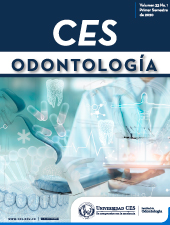Knowledge, attitudes, and practices of dentists in Colombia regarding bisphosphonate-induced osteonecrosis of the jaws
DOI:
https://doi.org/10.21615/cesodon.33.1.2Keywords:
Attitudes, bisphosphonates, dentistry, knowledge, osteonecrosis of the jaws, practicesAbstract
Introduction and objective: In order to provide proper dental management to patients who are under bisphosphonate therapy it is of critical importance that dentists perform a good anamnesis, a comprehensive clinical examination to asses for possible risk factors for bisphosphonate-induced osteonecrosis of the jaws (BIONJ). Although this issue has been explored in other parts of the world, in Colombia there is currently no scientific evidence to support it. Thus, the aim of this study was to compare knowledge, attitudes, and practices (domains) of general and specialist dentists regarding BIONJ. Materials and methods: Paper/online surveys that included questions about knowledge, attitudes, and practices regarding BIONJ were distributed and completed by 228 general dentists and 114 dental specialists in Colombia. Student’s t-test was used to determine statistical difference between groups of dentists (P < 0.05). Results: The attitudes domain was removed from the analysis as it did not meet statistical criteria. Overall rate of BIONJ knowledge was 55.8%, being 65.3% and 50.7% for specialists and general dentists respectively. The difference between these groups was statistically significant (P = 0.0004). Overall rate of adequate practices was 38.4%, being 44.6% for dental specialists, and 35.1% for general dentists. The difference between these groups was statistically significant (P = 0.023). Conclusion: The level of knowledge and good practices regarding BIONJ in Colombia was greater and better in dental specialists than in general dentists. Those with higher knowledge scores suggested greater educational efforts to spread knowledge among dentists about BIONJ.
Downloads
References
Murad MH, Asi N, Alsawas M., Alahdab F. New evidence pyramid. Evid Based Med. 2016; 21(4):125–7.
Marx RE. Oral and Intravenous Bisphosphonate–Induced Osteonecrosis of the Jaws. 2nd ed. IL: Quintessence; 2011.
Khan AA, Morrison A, Hanley DA et al. Diagnosis and management of osteonecrosis of the jaw: a systematic review and international consensus. J. Bone Miner Res. 2015;30(1):3–23.
Colella G, Campisi G, Fusco V. American Association of Oral and Maxillofacial Surgeons position paper on bisphosphonate-related osteonecrosis of the jaws--2009 update: the need to refine the BRONJ definition. J Oral Maxillofac Surg. 2009;67(12):2698–9.
Boff RC, Salum FG, Figueiredo MA, Cherubini K. Important aspects regarding the role of microorganisms in bisphosphonate-related osteonecrosis of the jaws. Arch. Oral Biol. 2014;59(8):790–9.
Otto S, Marx RE, Tröltzsch M et al. Comments on ´´diagnosis and management of osteonecrosis of the jaw: a systematic review and international consensus``. J Bone Miner Res. 2015;30(6):1113–5.
Espinoza SC, Novoa-Muñoz F. Advantages of ordinal alpha versus Cronbach’s alpha, illustrated using the WHO AUDIT test. Rev Panam Salud Publica. 2018;42:e65.
Urade M, Tanaka N, Furusawa K et al. Nationwide Survey for Bisphosphonate-Related Osteonecrosis of the Jaws in Japan. J. Oral Maxillofac. Surg. 2011;69(11):e364–71.
Wayne WD, Chad LC. Biostatistics a Foundation for Analysis in the Health Sciences. 11th ed. NJ: Wiley;2019.
de Lima PB, Brasil VL, de Castro JF et al. Knowledge and attitudes of Brazilian dental students and dentists regarding bisphosphonate-related osteonecrosis of the jaw. Support Care Cancer. 2015; 23(12):3421–6.
Alhussain A, Peel S, Dempster, L, Clokie C, Azarpazhooh A. Knowledge, practices, and opinions of ontario dentists when treating patients receiving bisphosphonates. J Oral Maxillofac Surg. 2015;73(6):1095–105.
Yoo JY, Park YD, Kwon YD, Kim DY, Ohe JY. Survey of Korean dentists on the awareness on bisphosphonate-related osteonecrosis of the jaws. J Investig Clin Dent. 2010;1(2):90–5.
Vassiliou V, Tselis N, Kardamakis D. Osteonecrosis of the jaws: clinicopathologic and radiologic characteristics, preventive and therapeutic strategies. Strahlenther Onkol. 2010;186(7):367–73.
Cosman F, de Beur SJ, LeBoff MS, Lewiecki EM, Tanner B, Randall S, Lindsay R; National Osteoporosis Foundation Clinician’s Guide to Prevention and Treatment of Osteoporosis. Osteoporos Int. 2014;25(10):2359-81.
Downloads
Published
How to Cite
Issue
Section
License
Copyright (c) 2020 CES Odontología

This work is licensed under a Creative Commons Attribution-NonCommercial-ShareAlike 4.0 International License.
| Article metrics | |
|---|---|
| Abstract views | |
| Galley vies | |
| PDF Views | |
| HTML views | |
| Other views | |



